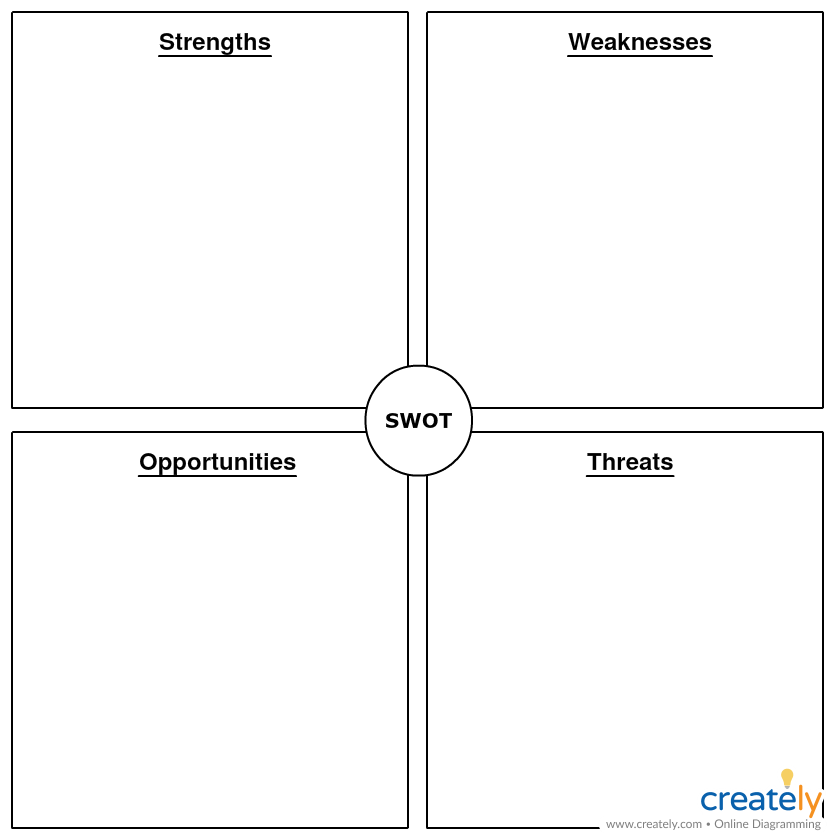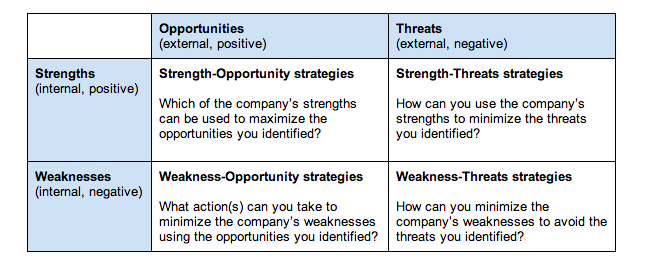Want a better way to evaluate your business?
Look no further than the SWOT analysis.
In this article, I’ll walk you through what a SWOT analysis is, how to conduct a SWOT analysis and a template to get you started!
What You’ll Learn:
- What is a SWOT analysis?
- When you should use one
- How to get started
- How to analyze your SWOT analysis
What is a SWOT Analysis?
Essentially, a SWOT analysis is a process designed to help a business make better decisions.
It does that by evaluating all factors involved in the decision-making process, separated into strengths, weaknesses, opportunities, and threats (SWOT).

SWOT breakdown, courtesy of Wordstream
The goal of the analysis is to help determine and understand those factors and apply them to future business decisions.
But, the actual SWOT analysis is just your blueprint. It’s will help you collect the needed information, but it’s up to you to analyze the information and decide how best to use it.
This means you’re in charge of creating an action plan to deal with any weaknesses or threats you discover and determining how to leverage the strengths you find and take advantage of opportunities.
When Should You Use a SWOT Analysis?
The cool thing about SWOT analysis: they’re flexible. They can be used to help in the planning of all things big and small, from major company initiatives to smaller tweaks in existing campaigns.
Truth be told, it should be used before making any kind of business action. Most often, you’ll see them for major activities, including:
- Possible new initiatives
- Implementing or deciding on new policies or strategies
- Altering or updating existing plans or campaigns
But you can also bring in a SWOT analysis when deciding things like your value proposition or even conducting a competitive keyword analysis.
When and why you choose to use SWOT will depend on your business structure, industry, goals, and upcoming initiatives. Now that you know when to use one, let’s get into how to conduct a SWOT analysis!
How to Conduct A SWOT Analysis: Getting Started
They are usually collected grid-style, with a dedicated bullet list for each SWOT section. Below is the most common template for how to do a SWOT analysis.

SWOT set-up
But formatting aside, you’ll want to do a little prep work before jumping in.
First and foremost, have a clear objective. Are you considering expanding your company’s services? Or making a tweak to your existing email marketing strategy?
Whatever the reason, know what it is and inform anyone involved in the analysis beforehand to keep on track.
You should also consider the following in your pre-SWOT planning:
- Put together a SWOT team (pun intended)- A SWOT analysis isn’t a one-man job. To get the best information, you want multiple minds brainstorming and evaluating. Keep the team tight; enough people for solid information, but not too much that you’re bogged down.
- Be honest – Don’t let egos get in the way. Honestly discuss your weaknesses or areas that could use improvement; it’s the only way for the analysis to work.
- Be specific – Keep your list simple, but be very specific when listing your items. For example, “we’re ranked #1 in SEO Services by x magazine,” rather than “we’re good at our job.”
- SWOT your competitors – To gain the best edge in the biz, it’s a good idea to run a SWOT test against your top 3 or 4 competitors as well. Obviously, you won’t have as much in-depth information, but it can be helpful to list out what you know to see where you have the edge and where you can improve relative to your competitors.
- Rank in order of importance – While every factor you list will likely be valid, it’s a good idea to go through and rank everything you compile in order of importance. For example, money. If you don’t have enough to accomplish what you’d like, that’s a major factor to consider. On the other hand, if you stand to get a sizable return, that could be a big deciding factor as well. Make sure you rank it accordingly.
SWOT Analysis: Strengths
In terms of a SWOT analysis, when we talk strengths we’re talking specifically about positive internal factors that you control.
What they are will depend on the objective of your analysis, but should consider:
- Personnel – leadership or management skills
- Market position
- Resources – $$
- Value proposition
- Competitive advantage
- Quality of your product or service
- Accolades
- Growth potential
And the list goes on. Of course, this could vary widely.
For example, if you’re looking into something more specific like a potential new direction for your social media strategy, your strengths would center around specific achievements or personnel dedicated to that aspect of business.
How to Identify Strengths:
You probably have a few of these in mind already, and there are plenty of questions to get things started.
The first thing you’ll want to do is revisit your goal: what part of your business is your SWOT analysis about?
So, if you’re looking at expanding sales, some questions to ask would be:
- What is your sales team best at?
- What benefits do your customers get from working with you?
- Do you have unique processes or services that separate you from the competition?
On the other hand, if you’re developing a marketing initiative, your questions would be geared more towards:
- What areas do your product or service beat the competition in?
- What are your highest profit margins?
- What are you most successful current marketing campaigns?
SWOT Analysis: Weaknesses
Okay, this is the part nobody likes.
But hey, it’s part of the process, and it requires (sometimes brutal) honesty. The good news? Getting those weak points out in the open is the only way to address and overcome them.
In a SWOT analysis, your weaknesses – like your strengths – address internal factors you can control. But this time, it’s the negative factors.
This is where it’s especially helpful to have your SWOT team on hand, especially anyone who can address areas of the business you may not be as involved with.
Because your weaknesses also address internal factors, your considerations will fall under many of the same categories as your strengths, including:
- Personnel (any lack in training, specialization, etc.)
- Market position (where are you weakest)
- Resources
- Competition
- Etc.
How to Identify Weaknesses:
Think broad to start, along the lines of:
- What areas does your business struggle in the most?
- Where are you weakest in regard to your competitors?
- Where are you losing sales?
- What reasons do customers select competitors over you?
Then, you can break it down to specifics. Take the sales example. If you’re looking to expand sales, you’ll have to take into consideration questions like: if you lost a sale, why did it happen? And, what do customers see as the biggest weakness in your sales process or product?
Similarly, if you want to expand your marketing scope but don’t have anyone who specialized in content, that could be a weakness to add to your list. Same goes if you have budgetary restrictions that keep you from being competitive in the YouTube space.
And remember: every business has weaknesses. Take the rose-colored glasses off and give it an honest, open-minded look.
SWOT Analysis: Opportunities
Next up: opportunities.
Both opportunities and threats refer to external factors. These may or may not be in your control (which will largely determine which category they fall into).
But first, the good news. Opportunities, as you can imply, represent the factors that you have a chance to capitalize on.
These could be things like:
- Emerging trends
- Economic trends
- New products or services
- Global influences
- New technologies
- Funding
Remember, there’s always opportunity. You just have to know where to look for it (hint: SWOT team).
How to Identify Opportunities:
These will have a lot to do with your specific industry or niche. And again, it’s a question and answer game.
This time, they might look something like this?
- How can we improve our sales or onboarding process?
- Are there any emerging trends?
- Which can benefit your business?
- Could you better allocate some of your resources?
- What kind of messaging and branding resonates most with our audience?
SWOT Analysis: Threats
And then come the threats. These are – as you likely guessed – the flip side of opportunities.
They’re also external factors, but they have the potential to have a far more negative effect.
Because these factors are often out of your control, it’s all too easy to ignore or disregard them. Don’t.
Instead, recognize them, and form a plan to minimize or deal with them in a way that impacts your business as little as possible.
How to Identify Threats:
The quickest way to find threats? Look at your competitors.
Are there any emerging competitors? Does one have a giant social following that dwarfs yours?
Also, it’s a good time to evaluate some of your weaknesses. Do any of them pose a particular threat to your business?
Market trends, personnel turnover, increasing competition, or poor sales could all spell potential threats, so make sure you account for them as you brainstorm.
Analyzing Your SWOT Analysis
So. You’ve successfully identified your strengths, weaknesses, opportunities, and threats.
Bad news? You’re not done.
Good news? You have a blueprint to form some solid strategies going forward.
To do that, you need to make the right connections between the quadrants in your SWOT analysis.
Generally, you want to:
- Maximize your strengths
- Use your strengths to take advantage of opportunities
- Use your strengths to minimize your threats
- Eliminate your weaknesses to avoid possible threats
- Improve on existing weaknesses by taking advantage of opportunities

SWOT strategies
I could go into all kinds of detail about the possible correlations here. But instead, let’s take a look at a few examples to see how a SWOT analysis can be put into action.
SWOT Analysis: Case Studies
First up: remember Blockbuster?
Well, your children probably don’t. Why? Because they had a relatively swift fall from grace – one that could have been avoided.

Blockbuster failed to realize the threat of on-demand streaming. And because of it, they went out of business completely.
Additionally, they relied too heavily on revenue from a practice that was increasingly unpopular with their customers: high late fee charges.
What they should have done instead was embrace the opportunity a changing market presented, and used their strengths to stay on top.
Instead, they let Netflix swoop in with their low costs and ease of use.
Blockbuster did eventually introduce a streaming service, but it was too little too late.
Had they taken the threat seriously and done more to address customer’s dissatisfaction with late fees, they could have still taken advantage of their name recognition and large customer base.
Instead, they stuck to their brick-and-mortar roots and, well the rest is history.
The same goes for Kodak. Their reluctance to accept the new digital camera format ultimately lead to their demise.
On the flip side, competitors like Netflix saw an opportunity (streaming service) and used it to overcome their weakness and possible threats (no name recognition or physical locations).
Concluding The SWOT Analysis
Bottom line: if you’re in any kind of business, you need to be using a SWOT analysis.
It could just save your business.